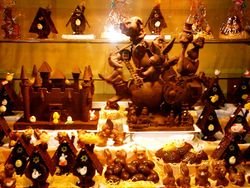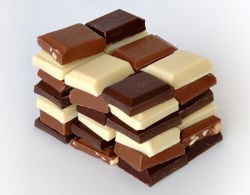
The chocolate residue found in an ancient Maya pot suggests that Maya were drinking
chocolate 2,600 years ago, the earliest record of cacao use. The Aztecs associated
chocolate with Xochiquetzal, the goddess of fertility. In the New World, chocolate was consumed in a bitter and spicy drink called xocoatl, often seasoned with vanilla, chile pepper, and achiote (which we know today as annatto). Xocoatl was believed to fight fatigue, a belief that is probably attributable to the theobromine content. Chocolate was an important luxury good throughout pre-Columbian Mesoamerica, and cocoa beans were often used as currency. Other chocolate drinks combined it with such edibles as maize gruel (which acts as an emulsifier) and honey.
The xocolatl was said to be an acquired taste. Jose de Acosta, a Spanish Jesuit missionary who lived in Peru and then Mexico in the later 16th century, wrote of it:
Loathsome to such as are not acquainted with it, having a scum or froth that is very unpleasant to taste. Yet it is a drink very much esteemed among the Indians, where with they feast noble men who pass through their country. The Spaniards, both men and women, that are accustomed to the country, are very greedy of this
Chocolaté. They say they make diverse sorts of it, some hot, some cold, and some temperate, and put therein much of that "chili"; yea, they make paste thereof, the which they say is good for the stomach and against the catarrh.
Christopher Columbus brought some cocoa beans to show Ferdinand and Isabella of Spain, but it remained for Hernando Cortes to introduce it to Europe more broadly.
The first recorded shipment of chocolate to the Old World for commercial purposes was in a shipment from Veracruz to Seville in 1585. It was still served as a beverage, but the Europeans added sugar and milk to counteract the natural bitterness and removed the chilli pepper, replacing it with another Mexican indigenous spice, vanilla. Improvements to the taste meant that by the 17th century it was a luxury item among the European nobility.
At the end of the 18th century, the first form of solid
chocolate was invented in Turin by Doret. This chocolate was sold in large quantities from 1826 by Pierre Paul Caffarel. In 1819 F. L. Cailler opened the first Swiss chocolate factory. In 1828 Dutchman Conrad J. van Houten patented a method for extracting the fat from cocoa beans and making powdered cocoa and cocoa butter. Van Houten also developed the so-called Dutch process of treating chocolate with alkali to remove the bitter taste. This made it possible to form the modern chocolate bar. It is believed that the Englishman Joseph Fry made the first chocolate for eating in 1847, followed in 1849 by the Cadbury brothers.
Daniel Peter, a Swiss candle maker, joined his father-in-law's chocolate business. In 1867 he began experimenting with milk as an ingredient. He brought his new product, milk chocolate, to market in 1875. He was assisted in removing the water content from the milk to prevent mildewing by a neighbour, a baby food manufacturer named Henri Nestlé. Rodolphe Lindt invented the process called conching, which involves heating and grinding the chocolate solids very finely to ensure that the liquid is evenly blended.


